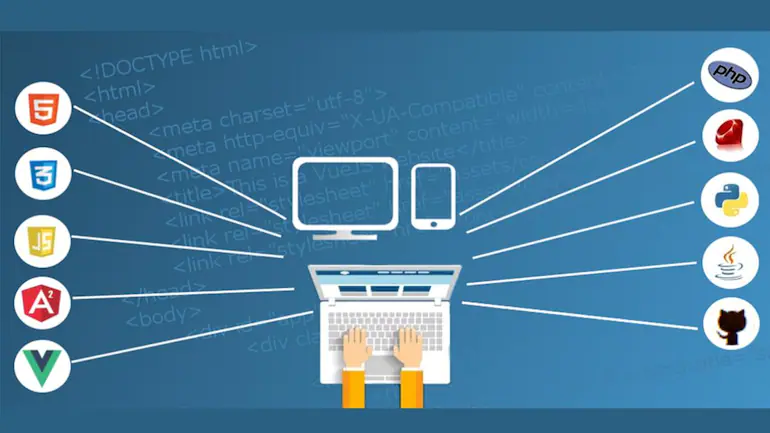You have probably heard about the term full-stack developer among knowledgeable peers or on tech forums, especially if you have started considering a career in programming/coding. But what is a full stack developer, and what does he do?
Simply, full-stack developers can be called the Swiss army knives of the development world. As experts in multiple programming languages, these accomplished experts can transition seamlessly from one development environment to another. A limitless curiosity drives full-stack developers: It’s not enough just knowing something works, and you have to know the how and why behind each feature.
Does this sound like you? If yes, read on. This post gives you a high-level overview of full-stack developers, where they fit into the development industry, and what they do.
Definition of a Full Stack Developer
In software programming, it helps to have an individual on your team who is a jack of all trades. They can help at different developmental levels and have time management and the versatility to help at all developmental team levels. If we talk about web development, this role belongs to the full-stack developer. This is not a backend or frontend developer but someone who has mastered both, a “full stack,” so to speak.
What Do Full Stack Developers Do?
A full-stack developer is an individual who works with both the
backend or server-side of the application and also the frontend or client-side.
Full stack developers have to possess knowledge in various programming niches, such as databases to UI/UX management databases, to do their job smoothly. They are ready to help wherever required in the process. Getting excited to know more about full stack development? Read this post to the end and enroll yourself in a full-stack web developer course.
Duties full stack developers do include:
- Assisting in the development and design of the software.
- Test and debug software to keep it optimal.
- Write clean code for the front and backend of the software.
- Design user interactions in the web application yourself.
- Create databases and software for the backend of the software.
- Ensure cross-platform optimization and compatibility.
- Test and maintain the responsive design of the software.
- Work with graphic designers to make new features.
- Develop RESTful services and API.
- Keep up with technological advancements for optimizing their software.
- Educate decision-makers on the effectiveness of new technology.
- Develop with security, maintainability, scalability, and more in mind.
In What Times a Full Stack Developer is Needed?
It all depends on the scalability and size of the software. For example, a small self-dependent game group consisting of a few people building a small simulator might have a backend developer and a frontend developer, and that might be it. They need it for their development. If they’re even smaller, they might have a full-stack developer handling the entire application. On the other hand, a massive web application with excellent scaling potential requires many hands on deck: Back-end, frontend, and full-stack developers.
Front-End, Back-End, and Full-Stack Web Developers: What’s the Difference?
The developer would be the part where the two charts are combined. In many cases, there is quite a bit of overlap between frontend and backend developers.
It’s essential to understand the responsibilities of frontend and backend developers so that you know what tasks a full-stack developer might need to fill in and help out.
Frontend Developers: Work with the user-facing systems and interface: Development of navigation, interface, and images – Focus on user experience – Use of HTML, JavaScript and CSS3 – They are the most aesthetically advanced web development position
Backend Developers: Deal with the database and server of the application – build the backends framework which enables the frontend development to exist – use Python, Ruby, and PHP – keep user info in the database.
Full-stack developer: Multidisciplinary web development skills with frontend and backend – Handling overlap between frontend and backend: Use all the primary two programming languages plus MySQL, machine learning, and more; take responsibility for the whole experience to ensure it works smoothly.
Background and Experience to Become a Full Stack Developer
Full stack developers are knowledgeable and highly educated people who have advanced through their education or years in similar industries in the workforce. These professions are in high demand, but managers don’t want to entrust their web development to just anyone. To be hired, full stack developers must meet special education and work experience standards. These vary from manager to manager, but here are some good bets.
Education: You will need an associate’s degree in computer science, computer programming, software programming, statistics, or a related field. You may not require more than an associate’s degree to apply for most jobs, but the higher your full stack developer certification, the better your chances of getting hired. Some full-stack developers even choose to get a master’s degree to differentiate themselves. An intensive web development boot camp is another way to learn all the skills needed to succeed as a full stack developer.
Work Experience: This isn’t a job that requires years of hands-on experience before applying, but don’t expect to learn everything in the apprenticeship either. He has the experience and knowledge to take on the job. This can be achieved through full training or previous experience in related development work. Some employers require you to have at least three years of experience with specific programming languages such as HTML, CSS, and JavaScript and to be informed about the latest developments.
Gain knowledge of the necessary skills to build full stack web applications with Hero Vired‘s program, which is designed to provide a holistic programming approach.

